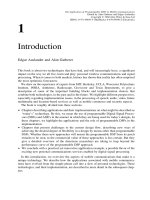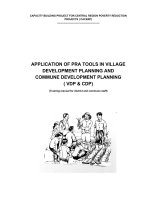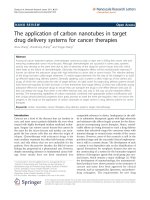Application of programmable DSPs in mobile communications 2002
Bạn đang xem bản rút gọn của tài liệu. Xem và tải ngay bản đầy đủ của tài liệu tại đây (4.7 MB, 391 trang )
The Application of Programmable
DSPs in Mobile Communications
The Application of Programmable DSPs in Mobile Communications
Edited by Alan Gatherer and Edgar Auslander
Copyright q 2002 John Wiley & Sons Ltd
ISBNs: 0-471-48643-4 (Hardback); 0-470-84590-2 (Electronic)
The Application of Programmable
DSPs in Mobile Communications
Edited by
Alan Gatherer and Edgar Auslander
Both of
Texas Instruments Inc., USA
JOHN WILEY & SONS, LTD
Copyright q 2002 by John Wiley & Sons, Ltd
Baffins Lane, Chichester,
West Sussex, PO19 1UD, England
National 01243 779777
International (+44) 1243 779777
e-mail (for orders and customer service enquiries):
Visit our Home Page on or
All Rights Reserved. No part of this publication may be reproduced, stored in a retrieval system, or
transmitted, in any form or by any means, electronic, mechanical, photocopying, recording, scanning or
otherwise, except under the terms of the Copyright Designs and Patents Act 1988 or under the terms of a
licence issued by the Copyright Licensing Agency, 90 Tottenham Court Road, London, W1P 9HE, UK,
without the permission in writing of the Publisher, with the exception of any material supplied speci-
fically for the purpose of being entered and executed on a computer system, for exclusive use by the
purchaser of the publication.
Neither the author(s) nor John Wiley & Sons Ltd accept any responsibility or liability for loss or damage
occasioned to any person or property through using the material, instructions, methods or ideas
contained herein, or acting or refraining from acting as a result of such use. The author(s) and Publisher
expressly disclaim all implied warranties, including merchantability of fitness for any particular
purpose.
Designations used by companies to distinguish their products are often claimed as trademarks. In all
instances where John Wiley & Sons is aware of a claim, the product names appear in initial capital or
capital letters. Readers, however, should contact the appropriate companies for more complete informa-
tion regarding trademarks and registration.
Other Wiley Editorial Offices
John Wiley & Sons, Inc., 605 Third Avenue,
New York, NY 10158-0012, USA
WILEY-VCH Verlag GmbH
Pappelallee 3, D-69469 Weinheim, Germany
John Wiley & Sons Australia Ltd, 33 Park Road, Milton,
Queensland 4064, Australia
John Wiley & Sons (Canada) Ltd, 22 Worcester Road
Rexdale, Ontario, M9W 1L1, Canada
John Wiley & Sons (Asia) Pte Ltd, 2 Clementi Loop #02-01,
Jin Xing Distripark, Singapore 129809
British Library Cataloguing in Publication Data
A catalogue record for this book is available from the British Library
ISBN 0471 48643 4
Typeset in Times by Deerpark Publishing Services Ltd, Shannon, Ireland.
Printed and bound in Great Britain by T. J. International Ltd, Padstow, Cornwall.
This book is printed on acid-free paper responsibly manufactured from sustainable forestry, in which at
least two trees are planted for each one used for paper production.
Contents
Biographies xiii
List of Contributors xv
1 Introduction 1
Edgar Auslander and Alan Gatherer
1.1 It’s a Personal Matter 2
1.2 The Super Phone? 3
1.3 New Services 6
1.4 The Curse and Opportunity of Moore’s Law 8
1.5 The Book 9
2 The History of DSP Based Architectures in Second Generation Cellular Handsets 11
Alan Gatherer, Trudy Stetzler and Edgar Auslander
2.1 Introduction 11
2.2 A History of Cellular Standards and Wireless Handset Architectures 11
2.2.1 1G and 2G Standards 11
2.2.2 2.5G and 3G Standards 12
2.2.3 Architecture Evolution 14
2.3 Trends in Low Power DSPs 17
2.3.1 Process Improvement 17
2.3.2 Instruction Set Enhancement 19
2.3.3 Power Management 21
References 21
3 The Role of Programmable DSPs in Dual Mode (2G and 3G) Handsets 23
Chaitali Sengupta, Nicolas Veau, Sundararajan Sriram, Zhenguo Gu and Paul Folacci
3.1 Introduction 23
3.2 The Wireless Standards 24
3.3 A Generic FDD DS Digital Baseband (DBB) Functional View 25
3.4 Functional Description of a Dual-Mode System 28
3.5 Complexity Analysis and HW/SW Partitioning 29
3.5.1 2G/3G Digital Baseband Processing Optimized Partitioning 31
3.6 Hardware Design Approaches 32
3.6.1 Design Considerations: Centralized vs. Distributed Architectures 32
3.6.2 The Coprocessor Approach 33
3.6.3 Role of DSP in 2G and Dual-Mode 37
3.7 Software Processing and Interface with Higher Layers 38
3.8 Summary 39
3.9 Abbreviations 39
References 40
4 Programmable DSPs for 3G Base Station Modems 41
Dale Hocevar, Pierre Bertrand, Eric Biscondi, Alan Gatherer, Frank Honore, Armelle Laine,
Simon Morris, Sriram Sundararajan and Tod Wolf
4.1 Introduction 41
4.2 Overview of 3G Base Stations: Requirements 42
4.2.1 Introduction 42
4.2.2 General Requirements 42
4.2.3 Fundamental CDMA Base Station Base Band Processing 43
4.2.4 Symbol-Rate (SR) Processing 44
4.2.5 Chip-Rate (CR) Processing 44
4.3 System Analysis 46
4.3.1 SR Processing Analysis 46
4.3.2 CR Processing Analysis 46
4.4 Flexible Coprocessor Solutions 48
4.4.1 Viterbi Convolutional Decoder Coprocessor 48
4.4.2 Turbo Decoder Coprocessor 50
4.4.3 Correlator Coprocessor 52
4.5 Summary and Conclusions 54
5 The Use of Programmable DSPs in Antenna Array Processing 57
Matthew Bromberg and Donald R. Brown
5.1 Introduction 57
5.2 Antenna Array Signal Model 58
5.3 Linear Beamforming Techniques 62
5.3.1 Maximum Likelihood Derivation 62
5.3.2 Least Mean Square Adaptation 66
5.3.3 Least Squares Processing 67
5.3.4 Blind Signal Adaptation 71
5.3.5 Subspace Constraints 73
5.3.6 Exploiting Cyclostationarity 75
5.3.7 Transmit Beamformer Techniques 77
5.4 Multiple Input Multiple Output (MIMO) Signal Extraction 83
5.4.1 MIMO Linear System Model 83
5.4.2 Capacity of MIMO Communication Channels 86
5.4.3 Linear Estimation of Desired Signals in MIMO Communication Systems 87
5.4.4 Non-linear Estimation of Desired Signals in MIMO Communication Systems 90
5.4.5 Conclusions 93
References 93
6 The Challenges of Software-Defined Radio 97
Carl Panasik and Chaitali Sengupta
6.1 Cellular Communications Standards 98
6.2 What is SDR? 98
6.3 Digitizing Today’s Analog Operations 101
6.4 Implementation Challenges 103
6.5 Analog and ADC Issues 103
6.6 Channel Filter 104
6.7 Delta-Sigma ADC 104
6.8 Conclusion 105
References 105
Contentsvi
7 Enabling Multimedia Applications in 2.5G and 3G Wireless Terminals: Challenges and
Solutions 107
Edgar Auslander, Madhukar Budagavi, Jamil Chaoui, Ken Cyr, Jean-Pierre Giacalone,
Sebastien de Gregorio, Yves Masse, Yeshwant Muthusamy, Tiemen Spits and Jennifer Webb
7.1 Introduction 107
7.1.1 ‘‘DSPs take the RISC’’ 107
7.2 OMAP H/W Architecture 111
7.2.1 Architecture Description 111
7.2.2 Advantages of a Combined RISC/DSP Architecture 113
7.2.3 TMS320C55x and Multimedia Extensions 113
7.3 OMAP S/W Architecture 114
7.4 OMAP Multimedia Applications 116
7.4.1 Video 116
7.4.2 Speech Applications 116
7.5 Conclusion 117
Further Reading 117
8 A Flexible Distributed Java Environment for Wireless PDA Architectures Based on DSP
Technology 119
Gilbert Cabillic, Jean-Philippe Lesot, Fre
´
de
´
ric Parain, Michel Bana
ˆ
tre, Vale
´
rie Issarny, Teresa
Higuera, Ge
´
rard Chauvel, Serge Lasserre and Dominique D’Inverno
8.1 Introduction 119
8.2 Java and Energy: Analyzing the Challenge 120
8.2.1 Analysis of Java Opcodes 120
8.2.2 Analyzing Application Behavior 121
8.2.3 Analysis 125
8.3 A Modular Java Virtual Machine 127
8.3.1 Java Implantation Possibilities 127
8.3.2 Approach: a Modular Java Environment 129
8.3.3 Comparison with Existing Java Environments 131
8.4 Ongoing Work on Scratchy 132
8.4.1 Multi-Application Management 133
8.4.2 Managing the Processor’s Heterogeneity and Architecture 133
8.4.3 Distribution of Tasks and Management of Soft Real-Time Constraints 133
8.4.4 Energy Management 133
8.5 Conclusion 133
References 134
9 Speech Coding Standards in Mobile Communications 137
Erdal Paksoy, Vishu Viswanathan and Alan McCree
9.1 Introduction 137
9.2 Speech Coder Attributes 138
9.3 Speech Coding Basics 139
9.3.1 Waveform Coders 141
9.3.2 Parametric Coders 141
9.3.3 Linear Predictive Analysis-by-Synthesis 143
9.3.4 Postfiltering 146
9.3.5 VAD/DTX 146
9.3.6 Channel Coding 146
9.4 Speech Coding Standards 147
9.4.1 ITU-T Standards 147
9.4.2 Digital Cellular Standards 148
9.4.3 Wideband Standards 152
Contents vii
9.5 Speech Coder Implementation 153
9.5.1 Specification and Conformance Testing 153
9.5.2 ETSI/ITU Fixed-Point C 154
9.5.3 DSP Implementation 155
9.6 Conclusion 155
Acknowledgements 156
References 156
10 Speech Recognition Solutions for Wireless Devices 160
Yeshwant Muthusamy, Yu-Hung Kao and Yifan Gong
10.1 Introduction 160
10.2 DSP Based Speech Recognition Technology 160
10.2.1 Problem: Handling Dynamic Vocabulary 161
10.2.2 Solution: DSP-GPP Split 161
10.3 Overview of Texas Instruments DSP Based Speech Recognizers 161
10.3.1 Speech Recognition Algorithms Supported 161
10.3.2 Speech Databases Used 161
10.3.3 Speech Recognition Portfolio 162
10.4 TIESR Details 165
10.4.1 Distinctive Features 165
10.4.2 Grammar Parsing and Model Creation 166
10.4.3 Fixed-Point Implementation Issues 167
10.4.4 Software Design Issues 168
10.5 Speech-Enabled Wireless Application Prototypes 168
10.5.1 Hierarchical Organization of APIs 169
10.5.2 InfoPhone 171
10.5.3 Voice E-mail 172
10.5.4 Voice Navigation 173
10.5.5 Voice-Enabled Web Browsing 174
10.6 Summary and Conclusions 175
References 176
11 Video and Audio Coding for Mobile Applications 179
Jennifer Webb and Chuck Lueck
11.1 Introduction 179
11.2 Video 181
11.2.1 Video Coding Overview 182
11.2.2 Video Compression Standards 186
11.2.3 Video Coding on DSPs 187
11.2.4 Considerations for Mobile Applications 188
11.3 Audio 190
11.3.1 Audio Coding Overview 191
11.3.2 Audio Compression Standards 193
11.3.3 Audio Coding on DSPs 195
11.3.4 Considerations for Mobile Applications 196
11.4 Audio and Video Decode on a DSP 198
References 200
12 Security Paradigm for Mobile Terminals 201
Edgar Auslander, Jerome Azema, Alain Chateau and Loic Hamon
12.1 Mobile Commerce General Environment 202
12.2 Secure Platform Definition 203
12.2.1 Security Paradigm Alternatives 204
12.2.2 Secure Platform Software Component 204
12.2.3 Secure Platform Hardware Component 205
Contentsviii
12.3 Software Based Security Component 205
12.3.1 Java and Security 205
12.3.2 Definition 205
12.3.3 Features for Security 206
12.3.4 Dependency on OS 207
12.4 Hardware Based Security Component: Distributed Security 207
12.4.1 Secure Mode Description 208
12.4.2 Key Management 210
12.4.3 Data Encryption and Hashing 211
12.4.4 Distributed Security Architecture 212
12.4.5 Tampering Protection 213
12.5 Secure Platform in Digital Base Band Controller/MODEM 214
12.6 Secure Platform in Application Platform 215
12.7 Conclusion 215
13 Biometric Systems Applied To Mobile Communications 217
Dale R. Setlak and Lorin Netsch
13.1 Introduction 217
13.2 The Speaker Verification Task 219
13.2.1 Speaker Verification Processing Overview 219
13.2.2 DSP-Based Embedded Speaker Verification 224
13.3 Live Fingerprint Recognition Systems 225
13.3.1 Overview 225
13.3.2 Mobile Application Characterization 226
13.3.3 Concept of Operations 226
13.3.4 Critical Performance Metrics 228
13.3.5 Basic Elements of the Fingerprint System 233
13.3.6 Prototype Implementation 247
13.3.7 Prototype System Processing 248
13.4 Conclusions 251
References 251
14 The Role of Programmable DSPs in Digital Radio 253
Trudy Stetzler and Gavin Ferris
14.1 Introduction 253
14.2 Digital Transmission Methods 254
14.3 Eureka-147 System 255
14.3.1 System Description 255
14.3.2 Transmission Signal Generation 262
14.3.3 Receiver Description 265
14.4 IBOC 279
14.5 Satellite Systems 284
14.6 Conclusion 285
References 286
15 Benchmarking DSP Architectures for Low Power Applications 287
David Hwang, Cimarron Mittelsteadt and Ingrid Verbauwhede
15.1 Introduction 287
15.2 LPC Speech Codec Algorithm 288
15.2.1 Segmentation 288
15.2.2 Silence Detection 288
15.2.3 Pitch Detection Algorithm 289
15.2.4 LPC Analysis – Vocal Tract Modeling 289
15.2.5 Bookkeeping 290
Contents ix
15.3 Design Methodology 290
15.3.1 Floating-Point to Fixed-Point Conversion 290
15.3.2 Division Algorithm 292
15.3.3 Hardware Allocation 293
15.4 Platforms 293
15.4.1 Texas Instruments TI C54x 293
15.4.2 Texas Instruments TI C55x 294
15.4.3 Texas Instruments TI C6x 294
15.4.4 Ocapi 294
15.4.5 A|RT Designer 294
15.5 Final Results 294
15.5.1 Area Estimate 295
15.5.2 Power Estimate 295
15.6 Conclusions 297
Acknowledgements 298
References 298
16 Low Power Sensor Networks 299
Alice Wang, Rex Min, Masayuki Miyazaki, Amit Sinha and Anantha Chandrakasan
16.1 Introduction 299
16.2 Power-Aware Node Architecture 300
16.3 Hardware Design Issues 302
16.3.1 Processor Energy Model 303
16.3.2 DVS 304
16.3.3 Leakage Considerations 306
16.4 Signal Processing in the Network 311
16.4.1 Optimizing Protocols 312
16.4.2 Energy-Efficient System Partitioning 313
16.5 Signal Processing Algorithms 317
16.5.1 Energy–Agile Filtering 318
16.5.2 Energy–Agile Data Aggregation 319
16.6 Signal Processing Architectures 320
16.6.1 Variable-Length Filtering 321
16.6.2 Variable Precision Architecture 322
16.7 Conclusions 324
References 324
17 The Pleiades Architecture 327
Arthur Abnous, Hui Zhang, Marlene Wan, George Varghese, Vandana Prabhu, Jan Rabaey
17.1 Goals and General Approach 327
17.2 The Pleiades Platform – The Architecture Template 329
17.3 The Control Processor 331
17.4 Satellite Processors 332
17.5 Communication Network 334
17.6 Reconfiguration 338
17.7 Distributed Data-Driven Control 339
17.7.1 Control Mechanism for Handling Data Structures 342
17.7.2 Summary 345
17.8 The Pleiades Design Methodology 345
17.9 The P1 Prototype 348
17.9.1 P1 Benchmark Study 350
17.10 The Maia Processor 352
17.10.1 Control Processor 353
17.10.2 Address Generator Processor 353
Contentsx
17.10.3 Memory Units 354
17.10.4 Multiply-Accumulate Unit 354
17.10.5 Arithmetic/Logic Unit 354
17.10.6 Embedded FPGA 354
17.10.7 Maia Results 355
17.11 Summary 357
References 358
18 Application Specific Instruction Set Architecture Extensions for DSPs 361
Jean-Pierre Giacalone
18.1 The Need for Instruction Set Extensibility in a Signal Processor 361
18.2 ISA Extension Capability of the TMS320C55x Processor 362
18.2.1 Control Modes 364
18.2.2 Dataflow Modes 366
18.2.3 Typical C55x Extension Datapath Architecture 367
18.2.4 Integration in Software Development Tools 370
18.3 Domains of Applications and Practical Examples 372
18.4 ISA Extensions Design Flow 376
References 377
19 The Pointing Wireless Device for Delivery of Location Based Applications 379
Pamela Kerwin, John Ellenby and Jeffrey Jay
19.1 Next Generation Wireless Devices 379
19.2 The Platform 379
19.3 New Multimedia Applications 379
19.4 Location Based Information 380
19.5 Using Devices to Summon Information 380
19.6 Pointing to the Real World 380
19.7 Pointing Greatly Simplifies the User Interface 381
19.8 Uses of Pointing 382
19.9 Software Architecture 382
19.9.1 Introduction 382
19.9.2 Assumptions 382
19.9.3 Overview 383
19.9.4 Alternatives 383
19.10 Use of the DSP in the Pointing System 383
19.11 Pointing Enhanced Location Applications 384
19.11.1 Pedestrian Guidance 385
19.11.2 Pull Advertising 386
19.11.3 Entertainment 386
19.12 Benefits of Pointing 387
19.12.1 Wireless Yellow Pages 387
19.12.2 Internationalization 387
19.12.3 GIS Applications 387
19.12.4 Entertainment and Gaming 388
19.12.5 Visual Aiding and Digital Albums 388
19.13 Recommended Data Standardization 388
19.13.1 Consideration of Current Standards Efforts 388
19.13.2 Device Data Types and Tiered Services 388
19.13.3 Data Specifications 389
19.13.4 Data Format 391
19.13.5 Is it Sufficient? 393
19.14 Conclusion 393
Index 395
Contents xi
Biographies
Alan Gatherer received his BEng degree in Electronic and Microprocessor Engineering from
Strathclyde University (Scotland) in 1988. He then moved to Stanford University and
obtained MS and PhD degrees, both in Electrical Engineering in 1989 and 1993. He joined
Texas Instruments in 1993. Since 1993, Dr. Gatherer has worked on digital communications
research and development in the areas of digital subscriber line, cable modem and wireless.
Presently he is a distinguished member of technical staff and manager of systems develop-
ment within Wireless Infrastructure at Texas Instruments where he leads a team involved in
the development of technology for third generation cellular telephony. He presently holds 11
patents in the field of digital communications.
Edgar Auslander is the Worldwide Strategic Marketing Director at Texas Instruments
Wireless Communications Business Unit, Dallas, Texas, working for the general manager
of the business unit and Texas Instruments’ senior vice-president. Some of the strategic plans
he has written have resulted in Texas Instruments acquiring or investing in companies. He
first worked at Texas Instruments in Nice, France, as European product marketing manager
for the TMS320 digital signal processors product line in 1990. Mr. Auslander became Texas
Instruments’ Worldwide GSM marketing manager in 1993 prior to his current position. He
obtained his MEEng and MBA degrees from Cornell University and Columbia Business
School in 1988 and 1990, respectively. While at Cornell, he held several teaching assistant
positions in signal processing and digital communications courses. While at Columbia Busi-
ness School, he was a teaching assistant in statistics and worked at the Office of Science and
Technology Development, selling Columbia Telecommunications Research Center’s patents
rights.
List of Contributors
Arthur Abnous
Care of Jan Rabaey
EECS Dept.
511 Cory Hall
Berkeley, CA 94720
USA
Edgar Auslander
Texas Instruments Inc.
12500 TI Boulevard, MS 8723
Dallas, TX 75243
USA
Jerome Azema
Texas Instruments France
821 avenue Jack Kilby - BP 5
06271 Villeneuve-Loubet Cedex
France
Michel Bana
ˆ
tre
INRIA-Rennes
Campus Universitaire de Beaulieu
35042 Rennes Cedex
France
Pierre Bertrand
Texas Instruments France
821 Jack Kilby Ave - BP 5
06271 Villeneuve-Loubet Cedex
France
Eric Biscondi
Texas Instruments France
821 Jack Kilby Ave - BP 5
06271 Villeneuve-Loubet Cedex
France
Matthew Bromberg
Dept. of Electrical and Computer Engineering
Worcester Polytechnic Institute
100 Institute Road
Worcester MA 01609-2280
USA
Donald R. Brown
Dept. of Electrical and Computer Engineering
Worcester Polytechnic Institute
100 Institute Road
Worcester MA 01609-2280
USA
Madhukar Budagavi
Texas Instruments Inc.
12500 TI Boulevard, MS 8649
Dallas, TX 75243
USA
Gilbert Cabillic
INRIA-Rennes
Campus Universitaire de Beaulieu
35042 Rennes Cedex
France
Anantha Chandrakasan
Massachusetts Institute of Technology
50 Vassar St. Rm 38-107
Cambridge, MA 02139
USA
List of Contributorsxvi
Jamil Chaoui
Texas Instruments France
821 Jack Kilby Ave - BP 5
06271 Villeneuve-Loubet Cedex
France
Alain Chateau
Texas Instruments France
821 avenue Jack Kilby - BP 5
06271 Villeneuve-Loubet Cedex
France
Gerard Chauvel
Texas Instruments France
821 avenue Jack Kilby - BP 5
06271 Villeneuve-Loubet Cedex
France
Ken Cyr
Texas Instruments Inc.
12500 TI Boulevard, MS 8650
Dallas, TX 75243
USA
Sebastien de Gregorio
Texas Instruments France
821 Jack Kilby Ave - BP 5
06271 Villeneuve-Loubet Cedex
France
Dominique D’Inverno
Texas Instruments France
821 avenue Jack Kilby - BP 5
06271 Villeneuve-Loubet Cedex
France
John Ellenby
GeoVector Corporation
601 Minnesota Street
#212 San Francisco
CA 94107
USA
List of Contributors xvii
Gavin Ferris
RadioScape Ltd.
2 Albany Terrace
Regents Park
London NW1 4DS
UK
Paul Folacci
Texas Instruments France
821, avenue Jack Kilby - BP 5
06271 Villeneuve-Loubet Cedex
France
Alan Gatherer
Texas Instruments Inc.
12500 TI Boulevard, MS 8723
Dallas, TX 75243
USA
Varghese George
Care of Jan Rabaey
EECS Dept.
511 Cory Hall
Berkeley, CA 94720
USA
Jean-Pierre Giacalone
Texas Instruments France
821 Jack Kilby Ave – BP 5
06271 Villeneuve-Loubet Cedex
France
Yifan Gong
Texas Instruments Inc.
12500 TI Boulevard, MS 8723
Dallas, TX 75243
USA
List of Contributorsxviii
Zhenguo Gu
Texas Instruments Inc.
12500 TI Boulevard, MS 8723
Dallas, TX 75243
USA
Loic Hamon
Texas Instruments France
821 avenue Jack Kilby - BP 5
06271 Villeneuve-Loubet Cedex
France
Teresa Higuera
INRIA-Rennes
Campus Universitaire de Beaulieu
35042 Rennes Cedex
France
Dale Hocevar
DSPS R&D Center
Texas Instruments Inc.
MS 8632 South Campus
12500 TI Boulevard
Dallas TX 75243
USA
Frank Honore
MIT
50 Vassar St., Rm 38-107
Cambridge, MA 02139
USA
David Hwang
427 Veteran Ave.
Los Angeles, CA 90024
USA
List of Contributors xix
Vale
´
rie Issarny
INRIA-Rennes
Campus Universitaire de Beaulieu
35042 Rennes Cedex
France
Jeffrey Jay
GeoVector Corporation
601 Minnesota Street
#212 San Francisco
CA 94107,
USA
Yu-Hung Kao
5505 Morehouse Drive
San Diego, CA 92121
USA
Pamela Kerwin
GeoVector Corporation
601 Minnesota Street
#212 San Francisco,
CA 94107,
USA
Armelle Laine
Texas Instruments France
821 Jack Kilby Ave - BP 5
06271 Villeneuve-Loubet Cedex
France
Serge Lasserre
Dominique D’Inverno
Texas Instruments France
821 avenue Jack Kilby - BP 5
06271 Villeneuve-Loubet Cedex
France
List of Contributorsxx
Jean-Phillipe Lesot
INRIA-Rennes
Campus Universitaire de Beaulieu
35042 Rennes Cedex
France
Chuck Lueck
6041 Village Bend Dr. #806
Dallas, TX 75206
USA
Yves Masse
Texas Instruments France
821 Jack Kilby Ave - BP 5
06271 Villeneuve-Loubet Cedex
France
Alan McCree
Texas Instruments Inc.
12500 TI Boulevard, MS 8649
Dallas, TX 75243
USA
Rex Min
Massachusetts Institute of Technology
50 Vassar St. Rm 38-107
Cambridge, MA 02139
USA
Cimarron Mittelsteadt
27150 Silver Oak Lane, Apt. #2012
Santa Clarita, CA 91351
USA
Masayuki Miyazaki
Hitachi Ltd., Central Research Laboratory
System LSI Research Dept.
1-280 Higashi-Koigakubo
Kokubunji-shi
Tokyo, 185-8601
Japan
List of Contributors xxi
Simon Morris
Lumic Electronics Inc.
18 Antares Dr Suite 200
Ottawa, Ontario
K2E 1A9
Canada
Yeshwant Muthusamy
Texas Instruments Inc.
12500 TI Boulevard, MS 8649
Dallas, TX 75243
USA
Lorin Netsch
Texas Instruments Inc.
12500 TI Boulevard, MS 8649
Dallas, Texas 75243
USA
Erdal Paksoy
Texas Instruments Inc.
12500 TI Boulevard, MS 8649
Dallas, TX 75243
USA
Carl Panasik
Texas Instruments Inc.
12500 TI Boulevard, MS 8723
Dallas, TX 75243
USA
Fre
´
de
´
ric Parain
INRIA-Rennes
Campus Universitaire de Beaulieu
35042 Rennes Cedex
France
List of Contributorsxxii
Vandana Prabhu
Care of Jan Rabaey
EECS Dept.
511 Cory Hall
Berkeley, CA 94720
USA
Jan Rabaey
EECS Dept.
511 Cory Hall
Berkeley, CA 94720
USA
Chaitali Sengupta
Texas Instruments Inc.
12500 TI Boulevard, MS 8723
Dallas, TX 75243
USA
Dale R. Setlak
709 S. Harbor City Blvd, 4th floor
Melbourne, FL 32902-2719
USA
Amit Sinha
Massachusetts Institute of Technology
50 Vassar St. Rm 38-107
Cambridge, MA 02139
USA
Tiemen Spits
Texas Instruments Inc.
12500 TI Boulevard, MS 8723
Dallas, TX 75243
USA
List of Contributors xxiii
Sundararajan Sriram
DSPS R&D Center
Texas Instruments Inc.
MS 8632 South Campus
12500 TI Boulevard
Dallas TX 75243
USA
Trudy Stetzler
Texas Instruments
12203 Southwest Freeway
MS 701
Stafford, TX 77477
USA
Nicolas Veau
Texas Instruments France
821, avenue Jack Kilby - BP 5
06271 Villeneuve-Loubet Cedex
France
Ingrid Verbauwhede
University of California, Los Angeles
Electrical Engineering Department
7440B Boelter Hall
420 Westwood Plaza
Los Angeles, CA 90095-1594
USA
Vishu Viswanathan
Texas Instruments Inc.
12500 TI Boulevard, MS 8649
Dallas, TX 75243
USA
Marlene Wan
Morphics Technology Inc.
675 Campbell Technology Parkway
Suite 100
Campbell, CA 95008-5059
USA
List of Contributorsxxiv
Alice Wang
Massachusetts Institute of Technology
50 Vassar St. Rm 38-107
Cambridge, MA 02139
USA
Jennifer Webb
7730 Woodstone Ln.
Dallas, TX 75248
USA
Tod Wolf
Texas Instruments Inc.
12500 TI Boulevard, MS 8632
Dallas, TX 75243
USA
Hui Zhang
Care of Jan Rabaey
EECS Dept.
511 Cory Hall
Berkeley, CA 94720
USA
List of Contributors xxv
1
Introduction
Edgar Auslander and Alan Gatherer
This book is about two technologies that have had, and will increasingly have, a significant
impact on the way we all live, learn and play: personal wireless communications and signal
processing. When it comes to both markets, history has shown that reality has often surprised
the most optimistic forecasters.
We draw on the experience of experts from MIT, Berkeley, UCLA, Worcester Polytechnic
Institute, INRIA, Authentec, Radioscape, Geovector and Texas Instruments, to give a
description of some of the important building blocks and implementation choices that
combine both technologies, in the past and in the future. We highlight different perspectives,
especially regarding implementation issues, in the processing of speech, audio, video, future
multimedia and location-based services as well as mobile commerce and security aspects.
The book is roughly divided into three sections:
† Chapters describing applications and their implementations on what might be described as
‘‘today’s’’ technology. By this, we mean the use of programmable Digital Signal Proces-
sors (DSPs) and ASICs in the manner in which they are being used for today’s designs. In
these chapters, we highlight the applications and the role of programmable DSPs in the
implementation.
† Chapters that present challenges to the current design flow, describing new ways of
achieving the desired degree of flexibility in a design by means other than programmable
DSPs. Whether these new approaches will unseat the programmable DSP from its perch
remains to be seen, as the commercial value of these approaches is less certain. But they
give a detailed overview of the directions researchers are taking to leap beyond the
performance curve of the programmable DSP approach.
† We conclude with a practical yet innovative application example, a possible flavor of the
exciting new personal communications services enabled by digital signal processing.
In this introduction, we overview the aspects of mobile communications that make it a
unique technology. We describe how the applications associated with mobile communica-
tions have evolved from the simple phone call into a slew of personal technologies. These
technologies, and their implementation, are described in more detail in the subsequent chap-
ters.
The Application of Programmable DSPs in Mobile Communications
Edited by Alan Gatherer and Edgar Auslander
Copyright q 2002 John Wiley & Sons Ltd
ISBNs: 0-471-48643-4 (Hardback); 0-470-84590-2 (Electronic)
1.1 It’s a Personal Matter
The social impacts and benefits of personal wireless communications are already visible.
When phones were not portable and used to only sit on a desk at home or at work, people
would call places: work or home; but when phones became portable and accessible anywhere,
people began to call people rather than places: today, when we call people we even often start
by asking ‘‘ Hello, where are you?’’ . The mobile phone has become a safety tool: ‘‘ I will bring
the phone with me in case I need to call for an emergency, if anxious family members want to
reach me, or if I am lost’’ . The mobile phone has become a social tool, enabling more flexible
personal life planning: ‘‘ I do not know where I will be at 2 p.m. and where you will be, but I
will call you on your mobile and we will sync’’. A recent survey has shown that when people
forget their mobile phone at home, a vast majority is willing to go back home to get it, even
when it implies a 30-minute drive. The mobile phone has become a personal item you carry
with you like your wallet, your drivers’ license, your keys, or even wear, like a watch, a pen,
or glasses: it made it to the list of the few items that you carry with you. If you are a teenager,
a gaming device or an MP3 player also made their room in your pocket, and if you are a busy
executive a personal organizer is maybe more likely to have this privilege. Figure 1.1
illustrates the integration of new features trend; conversely, the wireless communication
technology will be pervasive in different end-equipments and create new markets for wireless
modules embedded in cars for example.
To some, the use of a mobile phone in public places is an annoyance. Peer pressure
‘‘ dictates’’ you have a mobile phone to be reachable ‘‘ anywhere any time’’; not having a mobile
phone becomes anti-social in Scandinavian countries for example, where penetration is higher
than 70% of the whole population. Like for every disruptive technology widely used, a
new etiquette has to be understood and agreed upon, e.g. phones have to be turned off or put
The Application of Programmable DSPs in Mobile Communications2
Figure 1.1 Integration and exportation of functions to and from the mobile phone
in silent mode at concerts or in restaurants. Phones are now programmed with different ringing
profiles that are ‘‘ environment friendly’’ (e.g. meeting mode rings only once and makes the
phone vibrate). In the future, we might see phones that are environment aware, with sensors that
detect if the phone is ina bag and needs to ring louder for example. In the past, Matra-AEG, now
Nokia Mobile Phones, introduced a GSM phone that had an infra-red sensor that served as a
proximity detector so as to put the phone automatically on or off hands-free mode. Ringing
profiles have also other nice applications: paired with CallerID, they enable users to have
different ringing tones for different callers (friends, family, business partners, unknown…).
1.2 The Super Phone?
To the vast majority, the mobile phone is the ultimate telecommunication tool, via voice or
short messages, soon to become multimedia messages or multimedia communications.
For some, it is a foregone conclusion that wireless terminals will continue their mutation
from fairly simple, voice-oriented devices to smarter and smarter systems capable of
increasingly more complex voice and data applications. The argument goes that wireless
phones will take on the capabilities of Personal Digital Assistants (PDAs) and PDAs will
subsume many of the voice communications capabilities of mobile phones. This line of
reasoning proclaims that the handsets of the future eventually will become some sort of
super-phone/handheld computer/PDA. But in the end, the marketplace is never nearly as
neat and tidy as one might imagine. Rather than an inexorable quest for a one-size-fits-all
super-phone, the fractious forces of the market, based as they are on completely illogical
human emotions, no doubt will lead handset manufacturers down a number of avenues in
support of 2.5G and 3G applications (2.5 and 3G refer to coming phone standard genera-
tions to be described later in this book). Many mobile handsets will be capable of converged
voice/data applications, but many will not. Instead, they will fulfill a perceived consumer
need or perform a certain specialized function very well. Rather than a homogenous market
of converged super-phones, the terminal devices for next generation applications will be as
diverse as they are today, if not more so. And they will be as diverse as the applications that
will make up the 2.5G and 3G marketplace. Mobile device OEMs must be prepared to meet
the challenge of a diverse and segmented market. Figure 1.2 illustrates how wireless phone
service started to be affordable to a few privileged business professionals and how it
diversified in time to become a consumer item. The high-end phone of today is the classic
phone of tomorrow as fashion and technology evolve and as people become used to inno-
vations brought to them.
We believe that the increasing need for function diversification will drive the program-
mable DSP into an even more integrated role within the mobile devices of tomorrow. Non-
programmable DSP architectures will have to take on many traits of the programmable DSP
in order to compete with it. The later chapters of this book highlight that the future of
programmable DSPs in mobile applications hinges on their ability to bring the right level
of flexibility, along with low power performance.
Over the last several years, the market for terminals first became polarized and then
stratified. The market first polarized at the high and low ends of the spectrum. As more
features and functions could be added to handsets, they were and this made up the high
end. But to attract new subscribers, wireless carriers still wanted low-end, low-cost yet robust
Introduction 3




![godara, lal chand - crc handbook of antennas in wireless communications [2002]](https://media.store123doc.com/images/document/14/ri/si/medium_cL3g7P9GyO.jpg)




